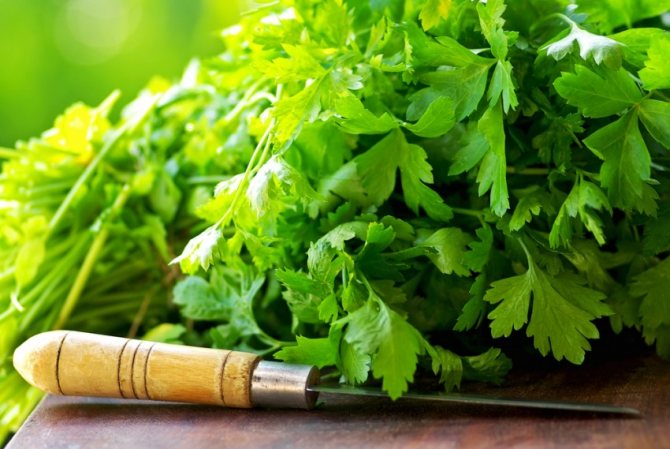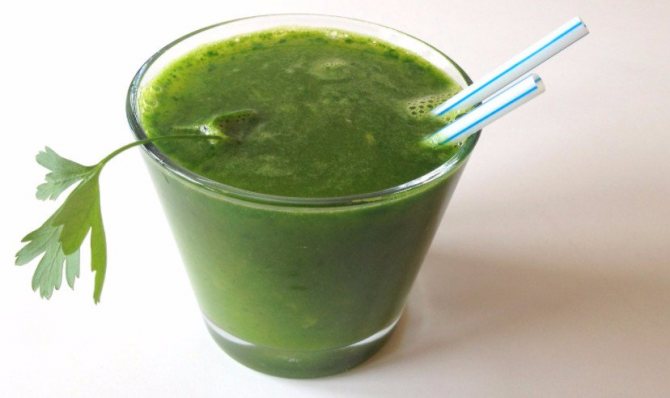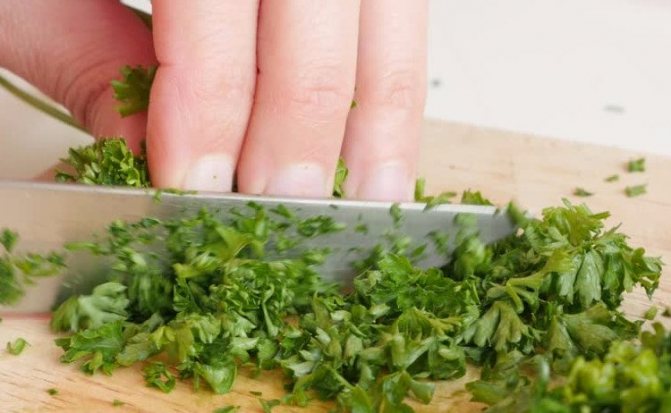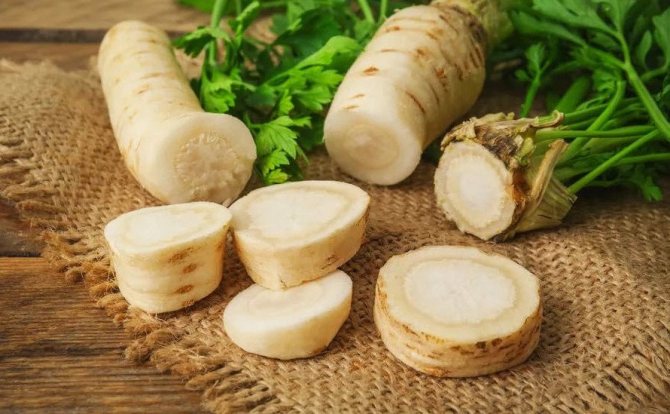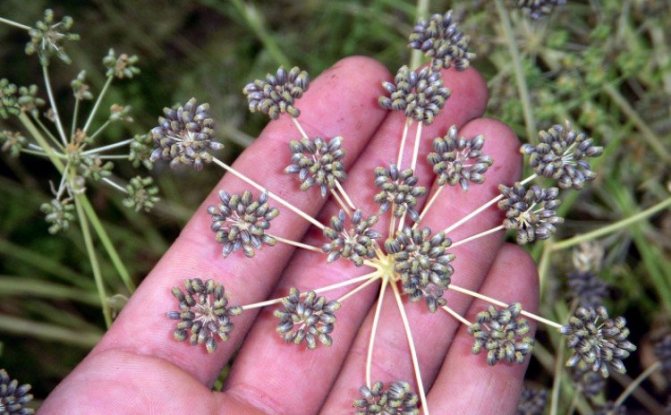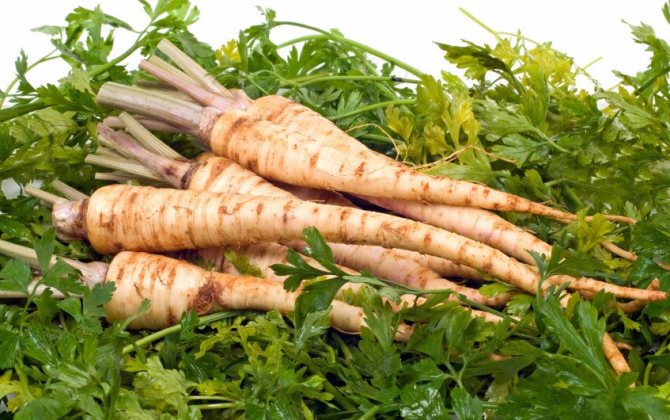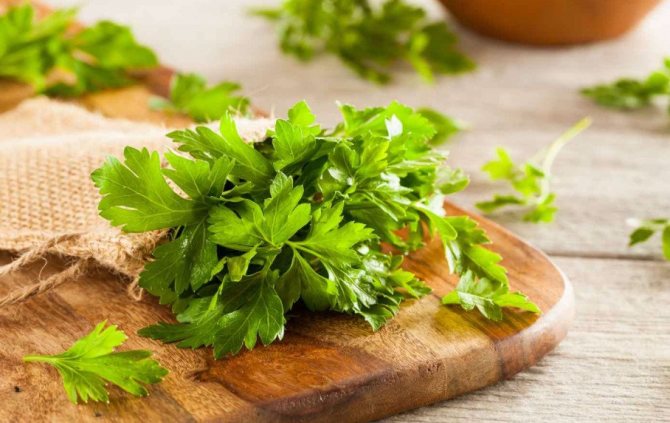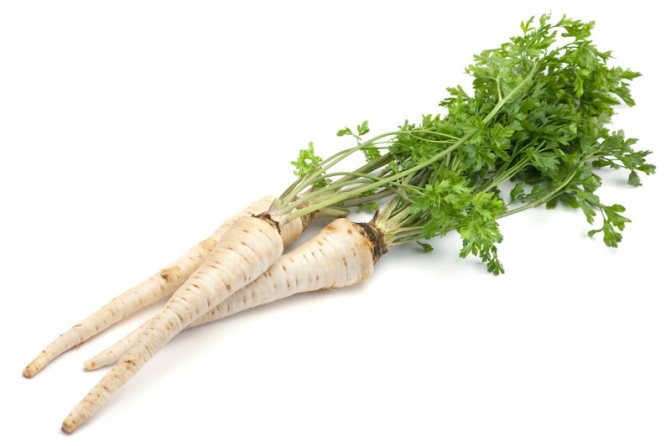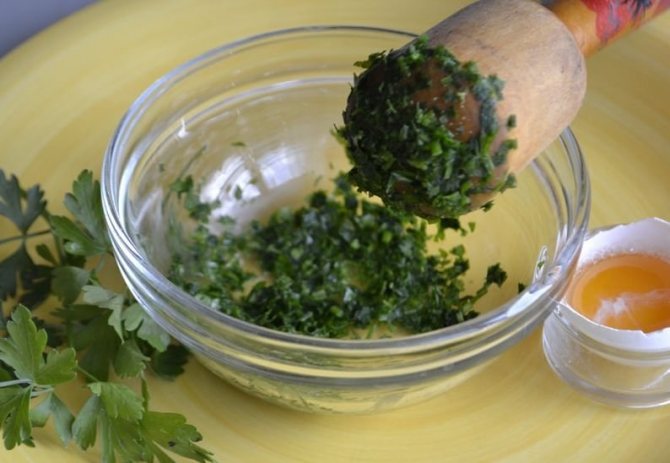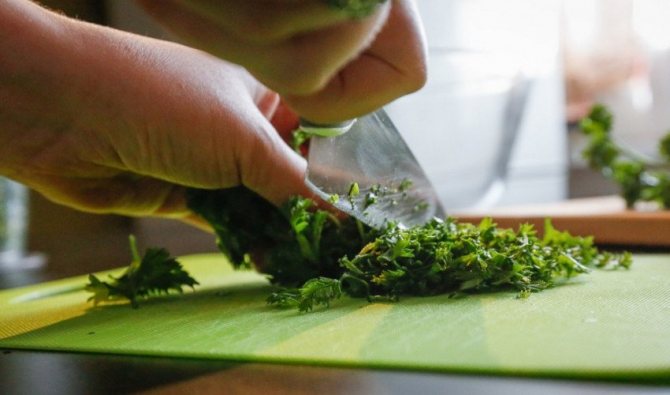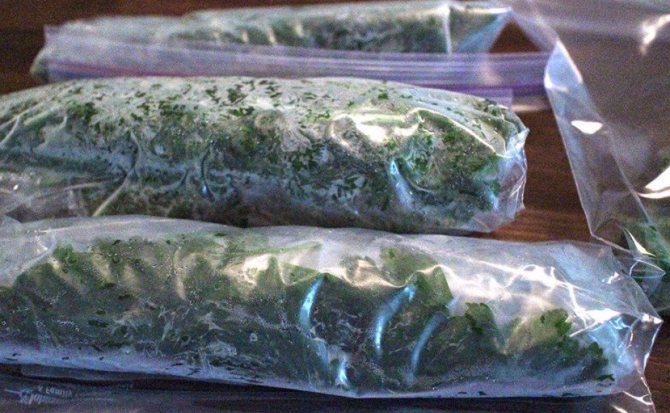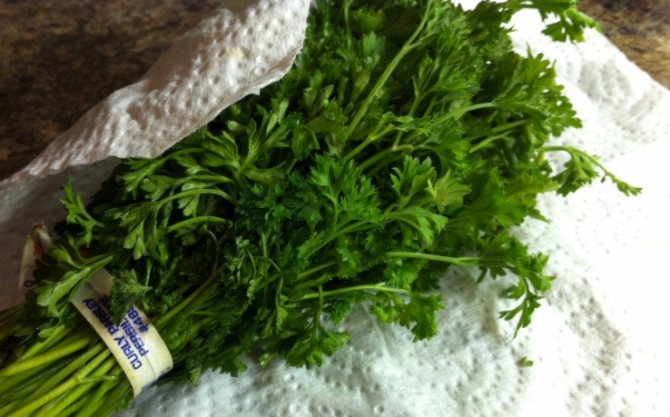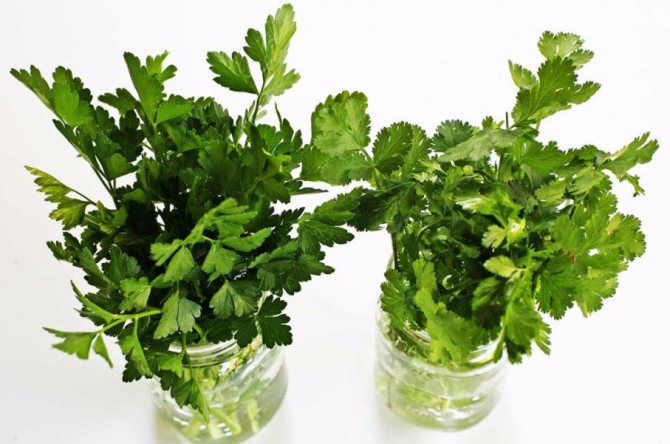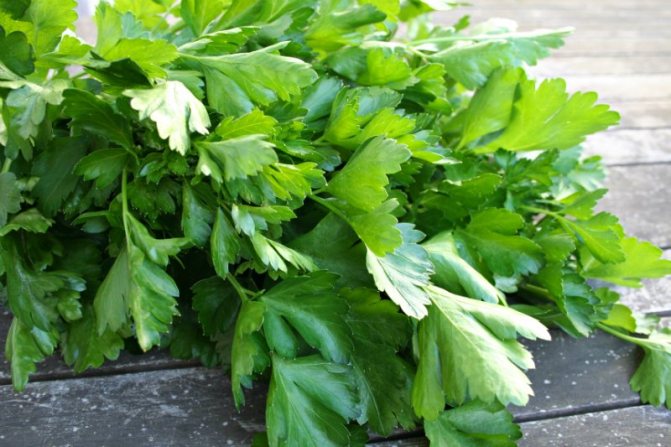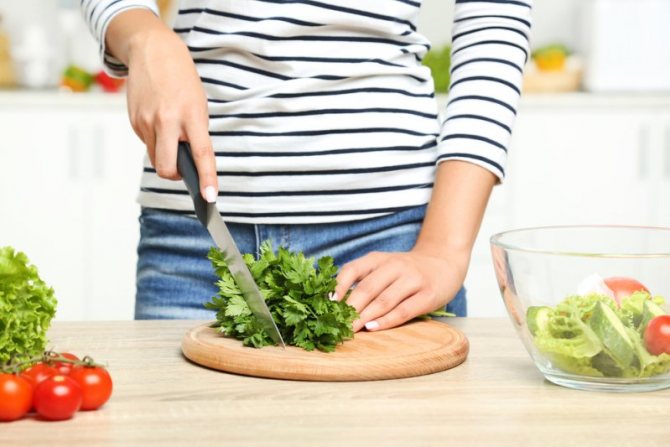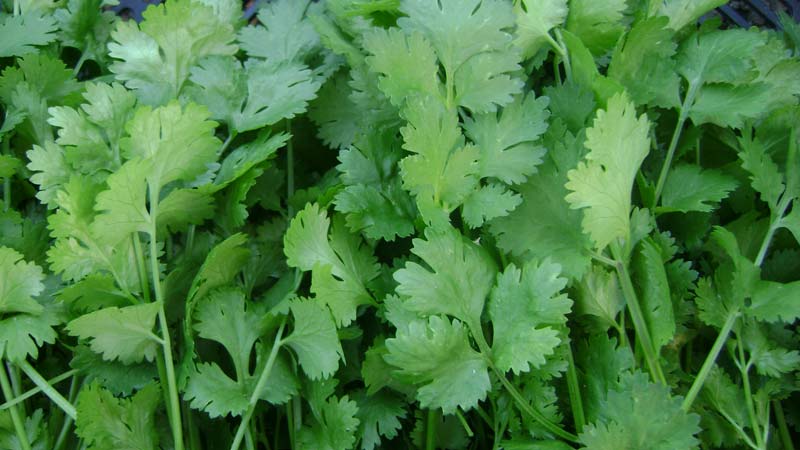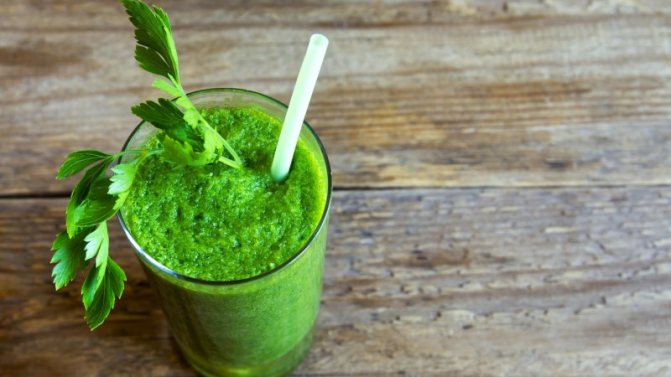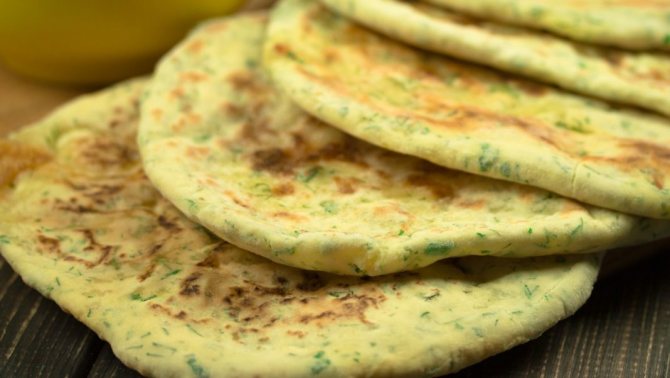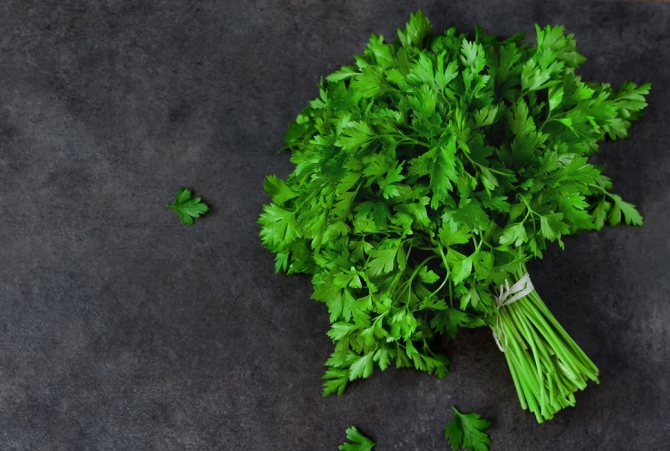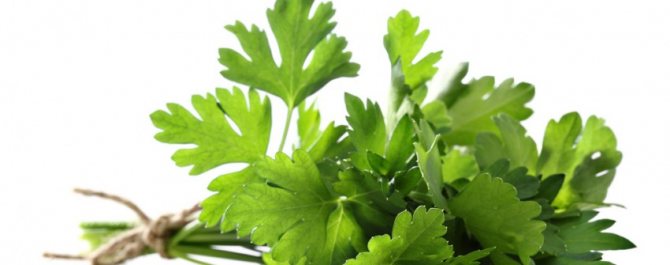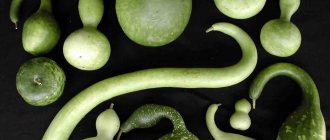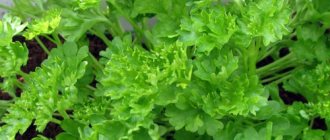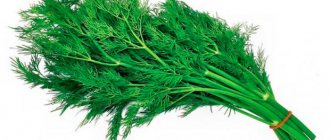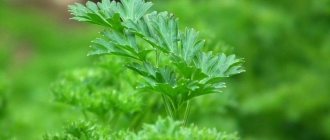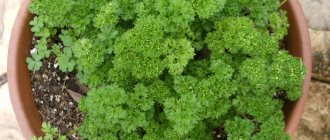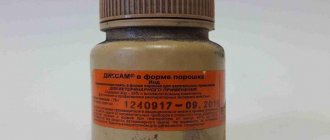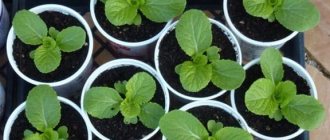- Calorie content and chemical composition
- Why parsley is good for women
- How to choose fresh herbs when buying What a quality product looks like
- Which one is better to refuse
- For painful periods
- Anti-wrinkle mask
Description and useful properties
In ancient Greece, parsley was used in religious rituals. Avicenna believed that the plant resolves tumors, it is useful for the liver, gastrointestinal tract, has a diuretic effect, dissolves stones, stimulates menstruation, therefore it is harmful for pregnant women.
Modern research confirms the benefits of parsley for protecting the liver, gastric mucosa and duodenal ulcer, relieving smooth muscle spasm, eliminating pain, and reducing high blood pressure. Greens, juice, roots have antioxidant, antidiabetic, laxative, diuretic, antibacterial, antifungal effects.
Biennial herb from the umbrella family 50-80cm high. The root vegetable is similar to white carrots. The dark green leaves glisten on top. In the first year, a rosette of leaves grows, in the second, flower stems. The flowers are small, in the form of an umbrella. Blooms from July to September.
Medicinal raw materials - grass (greens), roots, seeds.
Greens are used all year round. Harvested and dried in August.
Seeds - in August-September.
Roots - in August-September for a plant of 1 year of life, in spring - for a plant of 2 years of life.
The juice is squeezed in June-September from fresh leaves and roots. Due to its pronounced therapeutic effect, it is combined with other vegetable juices. Used to dissolve kidney stones, in case of inflammation of the bladder.
The benefits of parsley are to freshen the breath, eliminate bad breath, especially after eating garlic or onions. It is enough to chew some greens.
Asthenia, weakness:
- Brew with a glass of hot water 1c. L. seeds, boil for 30-40 minutes.
- Let cool, drain.
- Add boiled water to a full glass.
Take 2c l before meals. 3-4 times a day.
Flatulence:
- Brew with a glass of boiling water for 1 s.l. greens and seeds, simmer for half an hour, strain, bring the volume to a glass with warm water.
Take 3 times a day, 1 s. L. 20 minutes before meals.
Hair loss:
- Rub freshly squeezed juice into the scalp.
In what form is parsley used?
The herbal product can be consumed and applied in many different forms, not just greens. In addition to the deciduous part, seeds and root are of great benefit to the body.
Storing parsley
It can be stored fresh for about 2 weeks, but this period can be extended by tearing off all the green leaves and placing them in a glass container. In this form, the plant product will be stored for about 2-3 months. Another way to avoid quick spoilage is to freeze or dry, besides, fresh parsley is not always available for sale in winter.
The use of the plant is relevant for various purposes. Most often, greens are used as a seasoning for dishes. It complements well the taste of salads, meats and soups. Before using the product, if it was purchased in a store, it is necessary to fill it with cold water for an hour. If parsley grows in a garden or vegetable garden, it is enough to rinse it under running water. You can also use the plant in the following ways:
- The juice. The juice squeezed from the plant can be eaten for health purposes. A small amount of juice helps with cardiovascular diseases, vision and respiratory problems. To make the drink taste pleasant, parsley juice is usually mixed with cucumber or carrot juice. This fortified cocktail contains a maximum of vitamins.
- Root. The root part of the plant is used in cooking. It has a particularly interesting taste. This part of the plant contains rare nutrients that are not found in all other products. These include selenium, molybdenum, lithium, aluminum. The crushed root is used both fresh and dried. It provides a good diuretic effect, helps with flatulence, inflammatory processes.
- Seeds. A decoction of parsley seeds is very useful, helping with diseases of the gallbladder and liver, with diseases of the genitourinary system of the chronic type. This drink increases appetite, improves digestion. You can store raw materials at home. You can brew with some herbs in equal parts (the seeds are very light by weight).
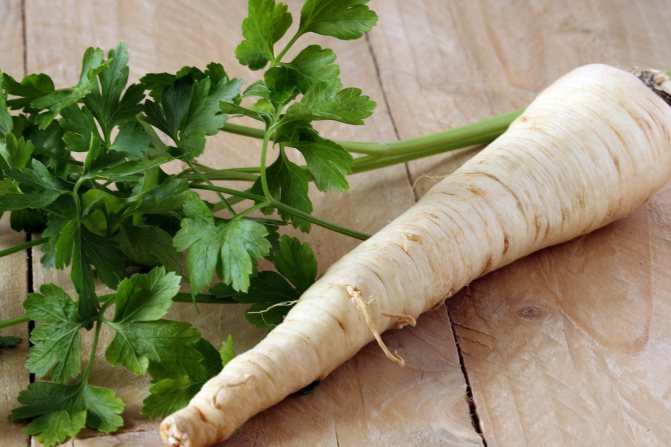
Parsley root
Frozen parsley
Frozen parsley is most convenient for everyday cooking. Before freezing, it must be well rinsed and dried, laid out on a paper towel, coarsely chopped, folded into an airtight bag and placed in the freezer. The plant product is frozen mainly in dry freezing chambers, but static ones are also suitable, it will not lose its benefits.
Calorie content and composition
The composition determines the benefits and harms of parsley. The table below shows the percentage of proteins, fats, carbohydrates, vitamins, minerals in 100 g of greens from the daily value (2000 kcal).
Table 1. Vitamins and minerals that determine the benefits and harms of parsley (greens)
| Substance | Content in 100g | % of the daily value |
| Calorie content | ||
| Total calorie content | 36.0 kcal | 2% |
| Carbohydrates | 22.1 kcal | |
| Fats | 6.6 kcal | |
| Protein | 7.2 kcal | |
| Carbohydrates | ||
| Total Carbohydrates | 6.3 g | 2% |
| Alimentary fiber | 3.3 g | 13% |
| Sahara | 0.9 g | |
| Fats | ||
| Total Fat | 0.8 g | 1% |
| Saturated fat | 0.1 g | 1% |
| Monounsaturated fat | 0.3 g | |
| Total Omega-3 | 8.0 mg | |
| Total Omega-6 | 115 mg | |
| Proteins and amino acids | ||
| Total proteins | 3.0 g | 6% |
| alanine | 195 mg | |
| arginine | 122 mg | |
| aspartic acid | 294 mg | |
| valine | 172 mg | |
| histidine | 61.0 mg | |
| glycine | 145 mg | |
| glutamic acid | 249 mg | |
| isoleucine | 118 mg | |
| leucine | 204 mg | |
| lysine | 181 mg | |
| methionine | 42.0 mg | |
| proline | 213 mg | |
| serine | 136 mg | |
| tyrosine | 82.0 mg | |
| threonine | 122 mg | |
| tryptophan | 45.0 mg | |
| phenylalanine | 145 mg | |
| cystine | 14.0 mg | |
| Vitamins | ||
| BUT | 8425 IU | 168% |
| carotenoids (lutein + zeaxanthin) | 5561 mcg | |
| B1 (thiamine) | 0.1 mg | 6% |
| B2 (riboflavin) | 0.1 mg | 6% |
| B3 (niacin) | 1.3 mg | 7% |
| B5 (pantothenic acid) | 0.4 mg | 4% |
| B6 (pyridoxine) | 0.1 mg | 4% |
| B9 (folic acid) | 152 μg | 38% |
| FROM | 133 mg | 222% |
| E (alpha-tocopherol) | 0.7 mg | 4% |
| TO | 1640 mcg | 2050% |
| Minerals and trace elements | ||
| iron | 6.2 mg | 34% |
| potassium | 554 mg | 16% |
| calcium | 138 mg | 14% |
| magnesium | 50.0 mg | 12% |
| manganese | 0.2 mg | 8% |
| copper | 0.1 mg | 7% |
| sodium | 56.0 mg | 2% |
| selenium | 0.1 μg | 0% |
| phosphorus | 58.0 mg | 6% |
| zinc | 1.1 mg | 7% |
Infusion, decoction
In treatment, parsley is more often used in the form of a powder from seeds, fresh or dried herbs, less often roots.
Infusion of greens:
- Brew with a glass of boiling water 4 tsp. fresh or dried herbs, leave for 4-6 hours in a sealed enamel bowl, drain.
Take 1 s. L. 4 times a day before meals.
Infusion of seeds:
- Brew 500 ml of boiling water 1 tsp. seeds, leave for 2-3 hours
Take 1/2 cup 3 times a day for a diuretic effect.
Cold infusion of seeds:
- Pour 1 liter of boiled water at room temperature 1 tsp. seeds, leave for 8-12 hours.
Take 1/2 cup 4-6 times a day against flatulence, normalization of the gastrointestinal tract.
Decoction of seeds:
- Brew with a glass of boiling water 4 tsp. seeds.
- Simmer for 15 minutes.
- Strain.
Take 1 s. L. 4-6 times a day.
Infusion of roots:
- Brew 1/4 cup boiling water 4 tsp. fresh or dry roots, insist 8-12 hours in a sealed enamel bowl, drain.
Take 1 s.l. 4 times a day 30 minutes before meals.
Decoction of roots for external use:
- Brew with a glass of boiling water 4c.l. fresh or dried roots.
- Simmer for 15 minutes.
- Let cool, drain.
Wipe to remove freckles, age spots. For white spots on the skin (vitiligo) add 1/10 of lemon juice.
Parsley tea:
- Brew 1/4 cup of chopped fresh herbs with a glass of boiling water or 2 tbsp. dried seasoning.
- Insist 5-10 minutes, drain.
- Add sugar, honey, lemon juice to taste.
Use as a sedative.
Application in home cosmetology
Cosmetologists have been using this spicy herb for a long time. Masks, lotions, tonics and infusions for toning and cleansing the skin are prepared from it.
Anti-wrinkle mask
An excellent substitute for ready-made anti-wrinkle creams will be a mass of parsley:
- 10 g of chopped greens are poured into 200 ml of boiled water and insisted for 3-5 hours.
- This solution is impregnated with a napkin and applied for 15 minutes on the face. You can make such a mask daily.
For dark circles under the eyes
The most powerful tools for INCREASING Dick
The guy went too far with the remedy ...
Build up mass
Learn more
In order to get rid of bruises under the eyes, it is recommended that parsley, crushed to gruel, be applied under the eyes for 15 minutes, after which they are washed with cool water. This mask will refresh the face and give a healthy look.
You can make such a compress:
- a tablespoon of herbs, pour 200 ml of boiling water and let it brew for ¼ hour;
- cotton pads are moistened in the infusion and applied to the eyes for 15 minutes.


If you want to get rid of black circles and at the same time nourish the skin, you can use this recipe: a teaspoon of chopped parsley and 2 of the same tablespoons of sour cream are mixed and applied for ¼ hours on the eyelids.
Important! The circles under the eyes will not disappear after one procedure. Such masks should be done regularly.
Whitening Facial Lotion
An excellent remedy for combating freckles and age spots is parsley lotion. In order to get rid of spots on the face, you must use the product daily as a tonic, morning and evening. It is not difficult to prepare it: 1 tablespoon is poured with ½ glass of boiling water and kept for about a minute on low heat.
After the broth is ready, it is cooled and filtered. Lemon can be added to enhance the effect. Store the tonic in the refrigerator.
To strengthen hair
To improve hair, you can use the following infusion:
- a teaspoon of crushed parsley seeds is mixed with alcohol and olive (corn) oil (2 teaspoons each);
- the resulting mass is rubbed into the scalp. These masks will restore the lost strength to the hair and give it a healthy shine.
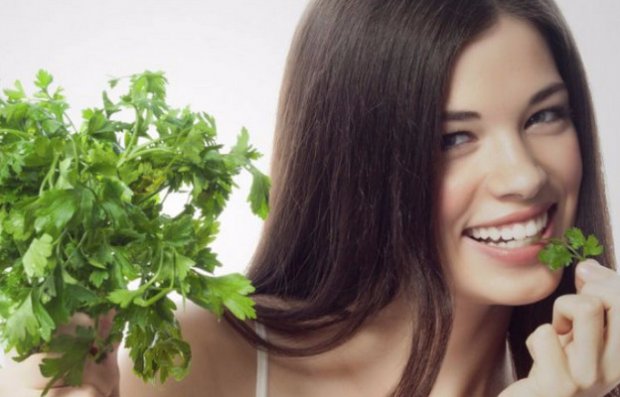

A heart
The benefits and harms of parsley for heart disease are determined by the high content of folic acid (vitamin B9). Some researchers believe that a decrease in homocysteine levels is beneficial - an increased level of this amino acid increases the risk of cardiovascular disease.
The benefits of parsley are in the high content of carotenoids, which prevent cardiovascular diseases, high blood pressure, and the level of "bad" cholesterol. This conclusion contains an overview of 2020.
Adequate intake of vitamin C, which is what parsley is good for, also lowers the risk of heart disease, as confirmed by a 2020 review.
Angina pectoris, ischemia:
- Brew 500 ml of boiling water 2 tsp. crushed dried leaves or roots, leave for 8 hours, drain.
Take roots - 1 s. L. 3-4 times a day, leaves - 1/2 cup 4-5 times a day. The duration of the preventive course in spring and autumn is 30 days.
Edema of the heart.
Recipe 1:
- Brew with a glass of boiling water 1c. L. chopped root, cover well, leave for 12 hours, drain.
Take 1 s.l. 4-5 times a day.
Recipe 2:
- Take juice of fresh root for 1-2 tsp. 3 times a day.
Recipe 3:
- Take seed powder, ground in a coffee grinder, 2-3 times a day on the tip of a knife.
Recipe 4:
- Pour 1 tsp with a glass of water. seeds, leave for 8 hours.
Take 1/4 cup 4 times a day.
Pericarditis (inflammation of the outer lining of the heart):
- Chop 2 medium parsley roots.
- Cook in 1.5L of water over low heat in a sealed container until 0.5L remains, strain.
- Add the juice of 2 lemons, 100 g of honey, mix thoroughly.
Take 1/3 cup 3 times daily before meals. Keep refrigerated.
How to choose fresh herbs when buying
Basically, the spice is sold fresh. Frozen product can be found occasionally, but some manufacturers still resort to freezing. You can buy greens almost everywhere: at the bazaar, in the store, in open stalls, etc.
Spicy herb is sold by weight, when you can independently choose the required volume, in bundles and in packages. But in any case, it is important to evaluate the quality of the product and identify potential flaws.
What a quality product looks like
You can be sure of the quality of greenery only when you have grown it yourself. And when purchasing, it is necessary to note a number of indicators, because a poor-quality product can not only harm the digestive system, but also harm the body as a whole.
Important! In roadside stalls, take parsley carefully. Any greenery quickly absorbs dust and becomes hazardous to health.
So, you can safely buy greens that:
- looks fresh, as if it had just been picked from the garden;
- dry, without drops of moisture, but not sluggish;
- clean, there is no dust or other contaminants on it;
- has a rich, uniform color;
- juicy (if there are wilted blades of grass, it is better to take another bunch);
- it has a bright aroma (the smell increases when broken or cut);
- the place of the incision is not dry and without a film (if, in addition, there are dry leaves, then the greens are spoiled);
- if a spice is selected in a package, then the container is intact;
- without signs of damage by parasites and various diseases;
- if the product is sold in cling film, then without moisture.
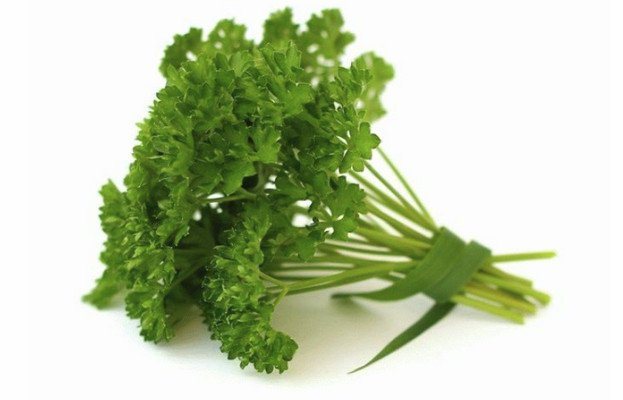

Did you know? Least of all, fresh parsley is loved in Europe and the USA. They prefer dried spices, which are convenient to store.
Which one is better to refuse
If you value your health, then in no case should you buy parsley in such cases:
- if the greens look like mint (perhaps this is how the traces of improper cultivation, storage and transportation were washed off);
- the spice has a sluggish appearance;
- there are traces of damage by diseases and pests on the leaves;
- the leaves are torn, with spots and incomprehensible bloom;
- the leaves began to turn yellow and dry (most likely, such grass was stored for a long time and incorrectly);
- sticky or overly shiny leaves indicate that the greens were treated with chemicals that may not wash off with water and harm health;
- when the greenery has a lot of damage (torn leaves, broken stems, etc.);
- parsley does not have a smell or has an unpleasant aroma (the lack of aroma occurs as a result of cultivation with the help of chemicals, and a bad smell can indicate rotting of the product);
- if the parsley is dusty and dirty.
Liver
A 2020 study confirms the liver-protective benefits of parsley in treating diabetes.
The benefits and harms of parsley for the liver are caused by vitamin C, carotenoids, flavonoids, coumarins, myristicin, and other beneficial substances.
Biliary dyskinesia, choleretic:
- Pour 500ml of boiled water at room temperature 1/2 tsp. parsley seeds, leave for 8-10 hours, drain.
Take 2-3c l. 3 times a day 20 minutes before meals.
Cholelithiasis:
- Chop dried parsley leaves or seeds.
Take 1 / 2-2g of powder 2-3 times a day.
Kidneys, bladder
Cystitis:
- Brew with a glass of boiling water 4 tsp. crushed seeds, simmer for 10-12 minutes, let cool, drain.
Take 1 s.l. 4-6 times a day, regardless of food intake.
Urolithiasis disease.
Recipe 1:
- Brew with a glass of boiling water 1 tsp. chopped fresh herbs and roots, cover well, leave for 2-3 hours.
Take 1/3 cup 1 hour before meals. In winter, use dried parsley.
Recipe 2:
- Brew 500ml boiling water 2c.l. chopped roots, leave for 2-4 hours, drain.
Contraindications


Despite the many beneficial properties of parsley, not everyone can use it. Contraindications include:
- The period of pregnancy (the plant is capable of provoking uterine bleeding and, ultimately, miscarriage or premature birth, since, among other properties, it also has a diuretic effect, ridding the body of excess fluid).
- Kidney pathologies (nephritis, gout, etc.) and urolithiasis (since the movement of large kidney stones is possible).
- Allergic reaction to the product.
- Impaired intestinal absorption of calcium.
Important! Parsley can and should be consumed during the hepatitis B period (2-3 months after childbirth), but this should be done correctly. So, in the first months of feeding, it is recommended to add it to soups and main courses (this way it is better absorbed) and not to exceed the daily norm - 50 grams.
In case of a negative reaction from the child's body (rash, swelling, etc.), the plant must be excluded from the diet.
Bones, joints
The benefits of parsley are high in vitamin K, which improves calcium absorption, reduces urinary excretion, strengthens bones, and reduces the risk of fractures, especially in old age, as confirmed by a 2020 review.
Also, the plant contains enough potassium, magnesium and calcium, which strengthen bone tissue.
Removal of pain, inflammation in joint diseases:
- Brew 500 ml of hot water for 1 tsp. chopped herbs and roots, leave for 9 hours.
Take 3 days for 2-3 s.l. before meals.
Tumors
The flavonoid myricetin, a high content of vitamins A, C eliminate inflammation, prevent atherosclerosis, Alzheimer's and Parkinson's diseases, and malignant tumors.
The benefits of parsley are in its composition apigenin, which has antioxidant, anti-inflammatory and anti-cancer properties, protects the mammary glands, as confirmed by a 2015 study.
Dietary fiber also reduces the risk of bowel, prostate, and ovarian cancer, as confirmed by a 2015 review.
Women
The benefits of parsley are in compounds that affect hormonal levels, estrogen production, stimulate menstruation, and milk secretion.
Profuse, painful, irregular periods.
Recipe 1:
- Brew with a glass of boiling water 4 tsp. seeds, simmer for 15 minutes, let cool, drain.
Take 1 s.l. 5-6 times a day between meals.
Recipe 2:
- Brew 500ml of boiled water at room temperature 1/2 tsp. parsley, leave for 8 hours, drain.
Take 2-3c l.every 2 hours.
Uterine bleeding:
- Brew 500 ml of boiling water in 1 s. L. greens and roots, leave for 4 hours, drain.
Take 1-2 s.l. 4 times a day half an hour before meals.
Insufficient lactation:
- Brew with a glass of boiling water 1c. L. seeds, simmer for 15 minutes, strain hot.
Take 1/4 cup 4-5 times a day.
Influence on potency
No scientific research has been done. But, centuries of experience says that parsley affects potency in several directions at once, which is very important. It contributes to:
- Strengthening attraction due to the properties of an aphrodisiac;
- Activation of blood flow in the prostate, due to which the work of the prostate improves, and the secretion produced is excreted from the body, as a result of which stagnation is prevented;
- Reducing inflammatory processes in the reproductive organs;
- Bringing hormonal balance back to normal by suppressing estrogens and stimulating the production of androgens;
- Toning the vessels of the genital organ.
For a quick restoration of potency, doctors recommend using a few leaves or 1-2 parsley roots. This will provide a more stable erection within 3 hours thanks to the intense testosterone production.
Men
Prostatitis.
Recipe 1 (in summer):
- Chop the root or fresh herbs.
- Brew a glass of boiling water 1c.l., insist overnight, strain in the morning.
Take 1 s. L. 4 times a day 30 minutes before meals.
Recipe 2 (in winter):
- Brew 1/2 cup boiling water 4 tsp. dried root, insist in a thermos for 8 hours.
Take 1 s. L. 4 times a day 30 minutes before meals.
Recipe 3:
- Mix 1-2 tsp. fresh juice with 1 tsp. honey.
Take 3 times a day before meals, course - 20 days. After 10 days, repeat the treatment - but add 1 tsp. aloe juice.



